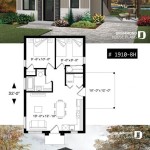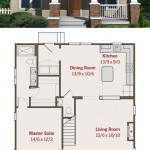Exploring the Benefits of House Plan Searching Using Japanese Keywords
Searching for house plans can be a complex process, even more so when navigating a foreign language and culture. For individuals interested in building or renovating a home with a Japanese aesthetic, understanding how to effectively utilize Japanese keywords in the house plan search is crucial. This article explores the benefits of adopting this approach, highlighting key advantages and specific terms that can significantly enhance the search process.
The Japanese architectural style, with its emphasis on natural light, open spaces, minimalist design, and integration with nature, has gained international popularity. Therefore, individuals seeking house plans that embody these characteristics often face the challenge of translating their vision into searchable terms. Relying solely on English keywords can lead to generic results that fail to capture the nuances of Japanese design principles. Employing Japanese keywords, on the other hand, can unlock a wealth of relevant information and resources, including plans specifically tailored to Japanese building codes and aesthetic sensibilities.
Moreover, many Japanese architectural firms and design resources primarily operate in Japanese. Limiting the search to English restricts access to this valuable pool of expertise and potentially superior designs. Using Japanese keywords allows for direct engagement with these resources, fostering a deeper understanding of the architectural concepts and facilitating more accurate plan acquisition.
Accessing a Wider Range of Design Options
One of the primary benefits of searching for house plans using Japanese keywords is the significantly wider range of design options that become available. The Japanese architectural landscape boasts a rich tradition of diverse styles, ranging from traditional Minka farmhouses to modern minimalist designs. These styles often incorporate unique spatial arrangements, material palettes, and construction techniques that are difficult to capture with generic English search terms.
For example, the term "和風住宅" (wafū jūtaku), which translates to "Japanese style house," is a broad term encompassing various traditional design elements. By searching this term, individuals can uncover plans that feature tatami mats, shoji screens, engawa verandas, and other characteristic elements of Japanese homes. Similarly, the term "数寄屋造り" (sukiya-zukuri) refers to a sophisticated and refined style of architecture often associated with tea houses, characterized by natural materials, asymmetrical layouts, and meticulous craftsmanship. Using this keyword can lead to the discovery of plans that embody the elegance and tranquility of this distinctive style.
Furthermore, searching in Japanese can reveal plans that cater to specific regional variations in Japanese architecture. Houses in Hokkaido, for example, often feature design adaptations to withstand harsh winter conditions, while homes in Okinawa may incorporate elements influenced by subtropical climates. These regional nuances are often overlooked in English-language searches, but become readily accessible when using relevant Japanese keywords.
The ability to search for specific design elements offers a significant advantage. Instead of relying on broad categories, individuals can target particular features of interest, such as "縁側" (engawa), meaning veranda, or "障子" (shōji), referring to paper screens. This level of granularity allows for a more precise and efficient search, ultimately leading to the discovery of plans that closely align with individual preferences.
Understanding Cultural Nuances and Design Intent
Beyond simply accessing a wider range of plans, searching with Japanese keywords facilitates a deeper understanding of the cultural nuances and design intent behind Japanese architecture. Japanese design is deeply rooted in cultural values and philosophical principles, such as harmony with nature, respect for materials, and the creation of tranquil and contemplative spaces. These values are often subtly embedded within the design, and fully appreciating them requires an understanding of the cultural context.
For instance, the concept of "間" (ma), which refers to the space between objects or the intentional use of emptiness, is a fundamental principle in Japanese design. It emphasizes the importance of negative space in creating visual balance and enhancing the overall atmosphere of a room. Searching for this term and exploring how it is applied in different house plans can provide valuable insights into the underlying design philosophy.
Similarly, the use of natural materials, such as wood, bamboo, and paper, is not merely an aesthetic choice but also reflects a deep respect for nature and a desire to create a harmonious living environment. Understanding the specific types of wood used in Japanese construction, such as "檜" (hinoki) or "杉" (sugi), and their associated properties can inform the selection of materials and contribute to a more authentic design.
By engaging with Japanese-language resources, individuals can gain a better understanding of the cultural symbolism embedded within architectural elements. For example, the placement of a garden lantern, or "灯籠" (tōrō), is often carefully considered to create a sense of tranquility and spiritual connection to nature. Learning about the different types of lanterns and their historical significance can enrich the design process and ensure that the architectural details are not merely decorative but also culturally meaningful.
Furthermore, using Japanese keywords can reveal information about the specific building codes and regulations that apply to Japanese-style homes. This is particularly important for individuals planning to build in Japan or in areas with strict building codes. Understanding these regulations ensures that the chosen house plan is not only aesthetically pleasing but also structurally sound and compliant with local laws.
Connecting with Japanese Architects and Design Professionals
A significant advantage of searching for house plans using Japanese keywords is the ability to connect directly with Japanese architects and design professionals. Many of the leading architectural firms and design studios in Japan maintain a strong online presence in Japanese, but their presence in English may be limited or non-existent. By using Japanese keywords, individuals can access these resources and potentially establish direct communication with the designers.
This direct connection can be invaluable for individuals seeking custom house plans or modifications to existing designs. Japanese architects possess a deep understanding of their architectural traditions and can provide expert guidance on how to best incorporate Japanese design principles into a modern home. They can also offer valuable insights into the selection of materials, the integration of sustainable design practices, and the adaptation of Japanese design to suit specific site conditions.
Searching for terms such as "建築事務所" (kenchiku jimusho), meaning architectural firm, or "建築家" (kenchikuka), referring to architect, can lead to the discovery of numerous Japanese architectural studios that specialize in residential design. These studios often showcase their work online, providing a portfolio of projects that can serve as inspiration and demonstrate their expertise.
Furthermore, engaging with Japanese architects can facilitate a more collaborative design process. By communicating directly with the designers, individuals can express their specific needs and preferences, and collaborate on creating a custom house plan that truly reflects their vision. This collaborative approach can lead to a more satisfying and personalized outcome.
In addition to architectural firms, there are numerous online forums and communities dedicated to Japanese architecture and design. These platforms provide a space for individuals to connect with other enthusiasts, share ideas, and seek advice from experienced professionals. Searching for these forums using Japanese keywords, such as "建築フォーラム" (kenchiku fōramu), can connect individuals with a valuable network of resources and support.
The ability to connect with Japanese architects and design professionals not only enhances the quality of the house plan but also provides an opportunity to learn more about Japanese culture and design philosophy. This can lead to a deeper appreciation for the architectural details and a more fulfilling living experience in a home that embodies the spirit of Japanese design.
In conclusion, searching for house plans using Japanese keywords offers numerous benefits, including access to a wider range of design options, a deeper understanding of cultural nuances, and the ability to connect with Japanese architects and design professionals. By embracing this approach, individuals can significantly enhance their house plan search and create a home that truly reflects their vision of Japanese design.

A Hypergraph Model Shows The Carbon Reduction Potential Of Effective Space Use In Housing Nature Communications

Shaking Table Tests Of A One Quarter Scale Model Concrete Hollow Block Masonry Houses Retrofitted With Fiber Reinforced Paint Scientific Reports

Pct Pph Japan Patent Office

How To Study Abroad In Japan 4 Simple Steps Ciee

Optimization Of Architectural Design And Construction With Integrated Bim Plm Methodologies Scientific Reports

7 Best Japan Study Abroad Programs Ciee

A Hypergraph Model Shows The Carbon Reduction Potential Of Effective Space Use In Housing Nature Communications

Kizuna Official The Government Of Japan Japangov

Study Abroad In Japan Faqs Ciee

Travel Less Specials
Related Posts








